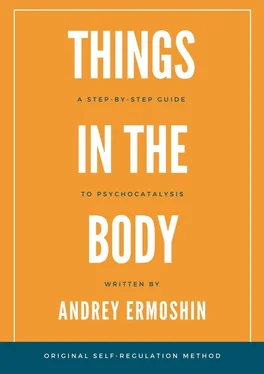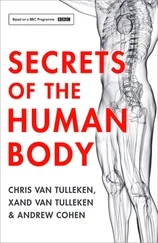From the actual
The general pattern is as follows: at the beginning of the appointment a patient is so full of different experiences that it is not necessary to look for them, they openly come out and it is easy to work with them. The patients can be quickly turned to talk about what they are experiencing. If they describe their body symptoms, such as ‘a stone in a soul’, it will only be necessary to specify if it is large or small, heavy, or light. If they mention the overloading of their forehead with restless thoughts, you can just ask: how many of them (thoughts) have accumulated there, whether they are large or small, what they are made of in their sensation , etc.
If the patient has previously conducted internal analytical work and managed to identify their condition, they declare fear, which limits their life, or jealousy, which drives them crazy, or resentment, which they do not know how to survive. It is also quite easy to turn their attention towards the description of the body sensations. «Where is your fear: in the head, in the chest, or in the stomach? Is it big, heavy, or light?». As soon as the first answers arrive, e.g. «My fear in my stomach, and it is big», you should immediately ask clarifying questions, e.g. «How many centimeters is it in diameter?», and thus lead the situation in the direction of identifying the plastic image of the experience, located on one of the levels of the body.
The usual dynamics of asking questions is as follows. Suppose that the patient complains to the severity in the chest, or finds there the feelings associated with the experience, which they manage to qualify as an offense. It is essential that the chest area is seen as problematic, concentrating all the sensations on itself.
Without any delay we specify:
«Is the heaviness in the chest big or small?
«Big,» the patient answers.
«How many kilos?» we continue to ask without any hesitation.
It can hardly be called a traditional way. As we have already mentioned, usually a doctor, after taking note of the symptoms, begins to establish a ‘nosology form’ thinking about the pills to prescribe to mitigate the painful manifestations. A psychologist embarks on a search for the psychological conflict that caused the disorder of the client. A healer immediately determines “the influence of an evil eye’ and starts to remove the ‘damage’. We have already talked about many options for the external use of the patient’s message. SPT also offers to continue asking questions and go into more detail about what has already been said. To make it easier for the patient to concentrate, you can offer them to close their eyes.
Closing the eyes, the patient responds:
«Ten kilos.»
«Ten kilos of what: gas? fluids? mass? wood? metal? stone? anything else? What does that feel like?»
«Stone.»
«What type?»
«Marble.»
«Shape?»
«Cube.»
«Size?»
«10 × 10 cm.»
Thus, we receive the initial information.
Please, note that we find out the characteristics of what is really felt . It is not a representation of something that does not exist.
So, in acute cases there are no problems with the beginning of the work, because the experience «strikes’ the energy circuit of a person or, rather, the contour of their feelings so much, that neither the patient nor the doctor finds it difficult to identify the «theme’ for work. The locus of experience also does not require long definition. The head «rips apart’ with the concerns, the chest is «pressed by resentment’, the fear «gathers all the power’ in one’s stomach, etc.
It is not so easy to determine the location of the «threshold’ and «sub-threshold’ experiences. In these cases, some tricks may be needed in order to find them and neutralize. Either it will be a subtle conversation, revealing the «zones of indifference’ of the patient, or something like what I want to describe as a special approach in the identification of hidden problems in the patient’s experience.
From the drawing
The beginning of ‘from the drawing’ is one of the favorites in my practice. The instruction to the patient is as follows: “Draw a symbolic figure of a person of squares, circles and triangles, the number of elements in the figure is 10”. If the patient has additional questions, it can be explained that the total number of elements that make up the figure is 10, but their quantitative ratio is arbitrary. It is advisable to draw without giving it much thought. It is possible to change the size of the squares, circles, triangles.
In some cases, I propose to color the figure and almost always to denote the age of the character. We will not consider the variety of options based on the constructive drawing of the person now. This is a separate topic. Let us examine only some cases of using this beginning. I was shown this test and some of the possibilities it offers by V. V. Libin 15 15 A. B. Libin, Libin B. B. Features of the preferences of geometric forms in the constructive drawings (psychographic test of preferences TiGR). Methodological guidance. M.: Institute of psychology, Russian Academy of Sciences, 1994
, to whom I am grateful.
The use of this test in somatopsychotherapy is different from Libin’s expert one, in which the quantitative ratio of geometric figures in the drawing is important to make the conclusion about the main problems of a patient and his personal style.
In our case, this task is used for a completely different purpose – therapeutic. The authors of the expert system recommend asking for five drawings of a human figure at once. In our ’therapeutic system’, this does not seem appropriate. The first drawing is the last one. It means that the state, genetically related to it, is immediately subjected to study.
Subsequent (post-therapeutic) products will be new, and again one picture will be enough to fix the change. I give importance to the age of the character (it is not practiced in the original test). I also use colors for this test.
Below there will be many specific examples of using the drawings. Now I would like to focus only on general issues.
The work with the drawings becomes relevant only after the obvious distortions in the patient’s condition are worked out. Psychotherapeutic communication goes into a new phase – the phase of cleaning the consciousness of ’polluting’ formations’ in a systematic mode. When the patient is generally calm and there are no other emergency topics for work today, then they get the task to draw a symbolic figure of a person of squares, circles, and triangles.
After the drawing is made and the age of the character is indicated, attention is transferred to the sensations in the body associated either with this drawing or (more often) with the age indicated near the drawing. «Where are the feelings associated with the age of N years? At the level of the head, chest, abdomen, or anywhere else?» As a rule, sensations are detected at the level of one of the mentioned zones and it turns out that they are associated with some experience, more often unpleasant, sometimes pleasant, but always significant.
When the first episode of work ends with the patient’s calmness, ’closing’ the old experience, an alternative, more productive response in such situations can be find. As soon as the cycle of work with a separate experience is completed, the same task can be given again – to draw a figure of a person from the already known elements. To give or not to give this task again depends on, firstly, whether the patient has enough strength to do another cycle of work, and secondly, on how much time is left till the end of the session. In case the patient is not tired and there is enough time left, work cycles can be repeated an unlimited number of times. Remarkably successful patients can work out up to 5—10 episodes per hour. But the general rule is one episode per a session.
Читать дальше












